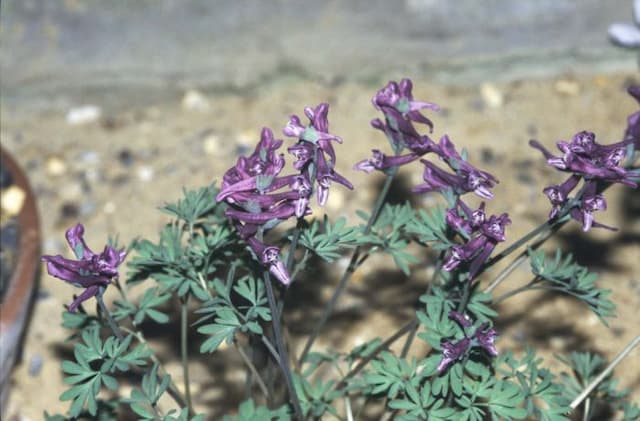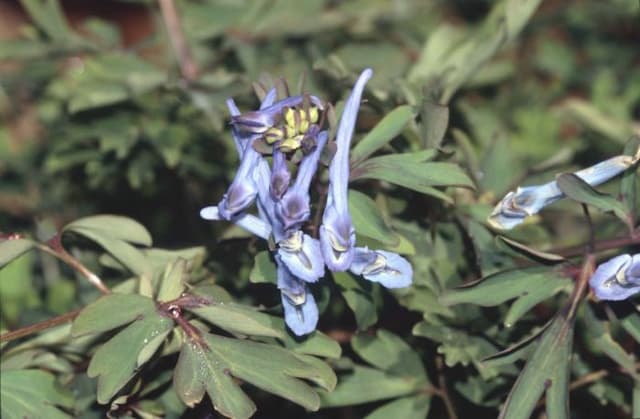Red Horned Poppy Glaucium corniculatum





ABOUT
The plant commonly referred to as the Red Horned Poppy is notable for its distinctive, showy flowers and gray-green foliage. The flowers are typically bright red or orange-red with a silky texture, having four petals that can be rounded or slightly notched at their tips. The center of the flower features a pronounced ovary that resembles a horn, giving the plant its common name. This horn-like structure adds an unusual aspect to the flower's appearance and is encircled by numerous stamens, which have dark purple to black anthers that contrast sharply with the petals' vivid coloration. The leaves of the Red Horned Poppy are equally striking, with a bluish or grayish-green hue, and they are densely covered with a fine downy texture that can make them appear almost silvery in sunlight. Leaf shape varies but often includes deep lobes, which create a feathery or ruffled appearance. The foliage forms a basal rosette from which the flowering stems arise. The overall impression of the Red Horned Poppy is one of vibrancy and unique beauty, with its combination of fiery-hued flowers and frosted foliage catching the eye in natural settings or cultivated gardens where it is used for ornamental purposes. Its characteristic horned seed pods also add to its ornamental appeal, providing interest even after the blooming period has finished.
About this plant
 Names
NamesFamily
Papaveraceae.
Synonyms
Red Horned Poppy, Horned Poppy, Horn Poppy, Sea Poppy.
Common names
Glaucium corniculatum.
 Toxicity
ToxicityTo humans
Red hornpoppy is known to contain several alkaloids that may be toxic to humans if ingested. These substances can cause gastrointestinal disturbances such as nausea, vomiting, and diarrhea. Depending on the amount ingested, more severe symptoms could potentially include neuromuscular and central nervous system effects.
To pets
Red hornpoppy contains alkaloids that can be toxic to pets if they ingest any part of the plant. Symptoms of poisoning in pets might include gastrointestinal upset, such as vomiting or diarrhea. In more serious cases, neurological symptoms such as tremors or seizures may occur, representing a need for immediate veterinary attention.
 Characteristics
CharacteristicsLife cycle
Biennials
Foliage type
Deciduous
Color of leaves
Blue-green
Flower color
Orange
Height
1-2 feet (30-60 cm)
Spread
1-2 feet (30-60 cm)
Plant type
Herb
Hardiness zones
8
Native area
Mediterranean
Benefits
 General Benefits
General Benefits- Ornamental Value: Glaucium corniculatum, commonly known as horned poppy, features vibrant flowers and distinctive foliage that add aesthetic appeal to gardens and landscapes.
- Drought Tolerance: Horned poppy is known for its ability to withstand dry conditions, making it suitable for xeriscaping and arid climate gardening.
- Erosion Control: The plant's extensive root system can help stabilize soil and prevent erosion on slopes and in coastal areas.
- Wildlife Attraction: The bright flowers of horned poppy attract a variety of pollinators, including bees and butterflies, which are essential for maintaining biodiversity.
- Low Maintenance: With its hardiness and ability to thrive in poor soils, horned poppy requires minimal care once established, making it an easy choice for low-maintenance gardens.
- Coastal Gardening: Horned poppy is well-adapted to sandy and saline soils, making it an excellent option for coastal and seaside gardens.
 Medical Properties
Medical Properties- Antitussive: Glaucium corniculatum might be used to alleviate cough symptoms.
- Diuretic: It may promote the removal of excess water from the body.
- Antispasmodic: The plant has potential use in relieving muscle spasms.
- Analgesic: It could be used to relieve pain.
- Expectorant: It might help in expelling phlegm or other material from the throat or lungs.
 Air-purifying Qualities
Air-purifying QualitiesThis plant is not specifically known for air purifying qualities.
 Other Uses
Other Uses- Glaucium corniculatum, commonly known as the red horned poppy, can be used to create a natural dye for textiles, providing a range of color from yellow to orange depending on the mordant used.
- The striking red flowers of the red horned poppy can be used in flower arrangements to add a pop of color and unique texture, enhancing the overall visual appeal of the display.
- In garden design, red horned poppy can be used as an ornamental plant, particularly suited for rock gardens and border edges due to its drought resistance and distinctive appearance.
- Due to its ability to adapt to poor soil conditions, red horned poppy can be used for soil stabilization in areas susceptible to erosion.
- As a photographer's subject, the red horned poppy provides an excellent opportunity to capture the intricate details and vibrant colors of wildflowers in natural light settings.
- The dried seed pods of Glaucium corniculatum have a unique shape that can be used in crafts or as decorative elements in dried floral arrangements.
- Red horned poppy can be included in educational programs about native and drought-resistant plants to promote environmental awareness and sustainable gardening practices.
- Insect habitat creation is another unusual use, as red horned poppy can attract and provide resources for pollinators such as bees and butterflies.
- For artists, the plant's unique forms and colors can serve as inspiration for botanical illustrations, paintings, and fine art photography.
- The plant can be involved in ecological studies to observe the interaction of native flora with the surrounding ecosystem, particularly in arid and semi-arid environments.
Interesting Facts
 Feng Shui
Feng ShuiThe plant Glaucium corniculatum is not used in Feng Shui practice.
 Zodiac Sign Compitability
Zodiac Sign CompitabilityThe plant Glaucium corniculatum is not used in astrology practice.
 Plant Symbolism
Plant Symbolism- Resilience: The Red Horned Poppy, as Glaucium corniculatum is commonly known, is able to grow in harsh conditions, symbolizing the ability to endure and survive through adversity.
- Beauty in Isolation: Often found growing alone in poor soil, this poppy represents the concept of finding beauty and flourishing even in isolation or under difficult circumstances.
- Transient Nature of Life: Like many poppies, the Red Horned Poppy has delicate flowers that do not last long, which can symbolize the fleeting nature of existence and the ephemeral beauty of life.
 Water
WaterThe Horned Poppy should be watered moderately, avoiding over-watering as it prefers well-drained soils. During the growing season, watering once a week with about 1 inch of water should be sufficient. Reduce watering in the winter when the plant is dormant. If the weather is particularly hot or dry, you may need to water twice a week, ensuring that the soil does not become waterlogged.
 Light
LightHorned Poppy thrives in full sunlight but can tolerate partial shade. It is best positioned in a spot where it receives at least six hours of direct sunlight daily. Avoid placing the plant in deep shade as this can impede its growth and flowering potential.
 Temperature
TemperatureHorned Poppy prefers a temperate climate with temperatures ranging between 50°F and 85°F. It can tolerate a minimum temperature of around 30°F, although frost may damage the foliage. The ideal temperature range for this plant is between 60°F and 75°F, where it can grow optimally.
 Pruning
PruningHorned Poppy benefits from deadheading, which encourages further blooming and prevents self-seeding if not desired. Pruning should be done after flowering, snipping off spent blooms. Additionally, you can cut back the plant in late autumn to help maintain its shape and prepare it for the next growing season.
 Cleaning
CleaningAs needed
 Soil
SoilHorned poppy thrives best in a well-drained, sandy or gritty soil mix with a pH of 6 to 7.5.
 Repotting
RepottingHorned poppy does not usually require frequent repotting and can often be left undisturbed for several years.
 Humidity & Misting
Humidity & MistingHorned poppy prefers a dry environment and does well in low humidity conditions.
 Suitable locations
Suitable locationsIndoor
Place horned poppy in bright light, minimal water.
Outdoor
Full sun, well-drained soil, water sparingly.
Hardiness zone
7-10 USDA.
 Life cycle
Life cycleGlaucium corniculatum, commonly known as Red Horned-poppy, is a biennial plant. In the first year, it begins with seed germination, typically in early spring, followed by the development of a basal rosette of leaves. During this vegetative stage, the plant focuses on growth and energy storage required for the next year. In the second year, it initiates the reproductive phase, where it grows a flowering stalk and blooms with bright red to orange flowers, usually in late spring or early summer. After pollination, typically by insects, the plant produces elongated, horn-shaped seed pods containing numerous seeds, which then mature and are dispersed by wind or other means. The life cycle ends once seeds are released as the plant dies, completing its biennial pattern, allowing for a new generation to begin the process again with seed germination.
 Propogation
PropogationPropogation time
Spring-Early Summer
Propogation: The most popular method of propagating Glaucium corniculatum, commonly known as the Red Horned Poppy, is through seed sowing. Seeds can be directly sown outdoors in either early spring or during the fall. It's important to just lightly cover the seeds with soil since they require some light for germination, which usually occurs in two to three weeks when the soil temperature is around 60-65°F (15-18°C). The Red Horned Poppy prefers well-drained soil and a position in full sun. Once the seedlings are large enough to handle, they can be thinned out to stand 12 inches (approximately 30 centimeters) apart to allow for proper growth and air circulation among the plants.









